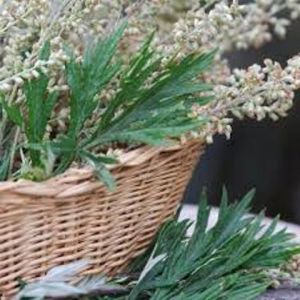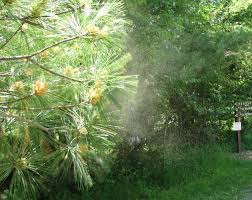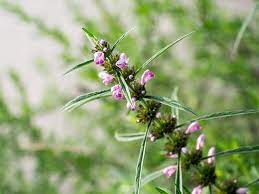_______________________________________________________________________________________________________________________
Herbs for Nerves

"Leverage the Power of Natural Healing Tools" Learn herbal remedies, diet and therapies to help heal your anxiety!
____________________________________________________________

Skullcap
Let’s face it, the world we live in is stressful for most people. Our modern western society moves at lightning speed, people are sleeping less than ever before, consumption of caffeine containing plants is at an all time high, and the stresses of our culture are having a major impact upon the health of the human nervous system.
Nervine herbs are a type of herbs intended to nourish and support the central nervous system. They restore balance and restfulness in the body.
Nervine herbs is one of the most important categories of herbal medicines for today's times. With stress, fatigue, insomnia, anxiety, and tension being some of the most common complaints it is important that you understand how nervine herbs work so you can help yourself.
Within this category of nervine herbs you will see a subgroup of herbs called adaptagens, which are so named because they help the body adapt to stress. While this is a critically important category of herbs, many of which have nothing short of remarkable effects on the human organism, they are oftentimes used out of context, as quick energy fixes, and can actually enable people to further their burnout symptoms. These popular remedies like Ashwaganda and Eleuthero are “the new Echinacea” and have become the most popular and discussed herbs in the natural products industry.
In my humble opinion, in cases of nervous system burnout the nervine herbs are actually better suited than the adaptogen herbs. People tend to reach a certain degree of nervous system burnout before they reach true glanduar burnout- or what most people commonly refer to as “exhausted adrenals.” which is not a good place to be.
What most people experience (especially younger folks) is nervous system exhaustion, and this is the place where the nervine herbs truly shine.
Different Types of Nervine Herbs
A nervine is a plant remedy that has a beneficial effect upon the nervous system in some way. This makes the word nervine into a bit of a catch-all expression, and to study them properly they must be differentiated into 3 major categories: nervine relaxants, nervine stimulants, and nervine tonics. Any successful treatment of nervous system problems with these herbs will involve treating the whole body and not simply the signs & symptoms. With life being such a stress and problem for humanity today these herbs can be of great use and importance.
1) Nervine Tonics are perhaps the most important contribution herbal medicine can make in the whole area of stress & anxiety, and in strengthening & “feeding” the nervous system.
- Avena sativa (Oats)
- Bacopa monniera (Brahmi)
- Borago officinalis (Borage)
- Centella asiatica (Gotu kola)
- Hypericum perforatum (St. John’s wort)
- Verbena officinalis (Blue vervain)
- Vinca major/minor (Periwinkle)
2) Nervine Relaxants are a group that has become increasingly important in our times of stress and tension. They are the closest natural alternative for the orthodox nerve tranquilizers, but should always be used in a broad holistic way. Too much tranquilizing, even that achieved through herbal medication, can in time deplete and weigh heavily on the whole nervous system. However, the physical symptoms that can so often accompany the ill-ease of anxiety, may be well treated with herbs that work on the anxiety itself. When the physical body is at ease, ease in the psyche is promoted. Note: In high doses many of these herbs can act as sedatives or hypnotics. Some herbal examples include:
- California Poppy
- Lavendula off. (Lavender)
- Humulus lupulus (Hops)
- Melissa off. (Lemon Balm)
- Matricaria recutita (Chamomile)
- Stachys off. (Wood Betony)
- Scutelleria lateriflora (Skullcap)
- Passiflora incarnata (Passionflower)
- Tilia europea (Linden)
- Lactuca virosa (Wild Lettuce)
- Piper methysticum (Kava Kava)
- Valerian
3) Nervine Stimulants cause a direct stimulation of the nervous system, and not often needed in our times of hyperactivity. We will not be using this category because our aim is to calm not stimulate. However is it useful to know what foods and herbs are nervine stimulants to avoid or reduce their use in your daily life. A problem with commonly used stimulants (such as coffee) is that they have a number of side effects and can themselves be involved in causing many problems such as anxiety and tension. Some herbal examples include:
- Cola vera (Kola)
- Coffea arabica (Coffee)
- Camellia sinensis (Green/Black Tea)
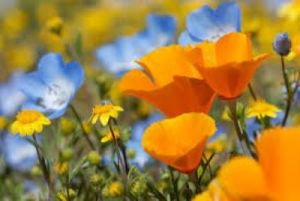
California Poppy
The Characteristics of Nervine Herbs
The old-time healers had to depend on their senses to develop the art of knowing what plants had a potential for healing. They observed the many ways the plants can speak to us from the colour of their flowers, to the type of roots, the shape of the leaves and the environment they grow in and much more. To fully understand an herb and its healing potential is to fully observe and translate the unique language you might call it 'decoding nature' herself.
The Doctrine of Signatures is an old European methodology that has fallen out of favour in the last hundred years. This doctrine was used to determine if an herb could be used for medicinal purposes. The criteria were based on whether the plant resembled the body's organ that required assistance or if the colour matched the body fluids, i.e. red flowers for blood problems. In the case of nervous conditions, anxiety, depression and stress the the aerial parts of the flowers and leaves were considered as they related to the upper part of the body encompassing the head and throat. The colours on the herbs especially the flower colours of blue and purple were indicated for the head as well. As you moved further down the body the roots were looked at for deep rooted physical issues.
Additionally, the environment the herb grew in may indicate how the plant may be used, i.e. a plant growing in a wet, swampy environment meant the herb might be helpful for a fluid imbalance of the body. Sometimes the herbs looked like the illness itself. The taste and smell were all considered, and all cultures used their senses to learn about the plants before scientific methodology came into practice.
The Doctrine of Signatures is no longer considered valid by the world of science, but that does not mean that the patterns and blueprints of nature cannot be observed and recorded. For example, the common names of many plants tell of their use, and remarkably many medicinal plants do follow the criteria of the Doctrine of Signatures.
There is a well-known herbalist called Mathew Wood, who still uses this methodology as well as more modern scientific research. I believe there is a place for the Doctrine of Signatures in learning about the plants if only to hone one's observations and as a memory tool. Just because something is old does not necessarily mean it does not bear looking at it. Besides, it is enjoyable and magical to view the plants as telling us how to work with them.
Let's look at what the Doctrine of Signatures applies to the group of herbs called nervines.
Plant Environments
Where a plant naturally grows gives information as to its potential healing properties. Plants consist of the elements: earth, water, air, and fire, the latter being present as heat or sunshine. So, for example, a hot climate on a sunny day brings a lot of the fire element to the plant. So it follows each environment with its unique mixture of elements will produce different elemental properties.
The influence of the environment on medicinal properties is well known. Plants grown in their ideal climate and soil will have the highest potency of their healing properties. Therefore lavender grown in the warm Mediterranean climate will be much more potent than lavender grown in a colder North American temperate climate. On the contrary, goldenseal will be at its highest potency in the same cooler climate and will not thrive in too much heat!
All of these factors can tell one of the internal temperatures of the plant itself: is it a hot herb or a cool herb depends on where it lives, as well as how much sunshine or shade it likes. As a point of interest, many of the nervine herbs enjoy sunny environments. You can see how this will translate into bringing light into a person's body.
Compared to cultivated plants, wild plants also exhibit more potency as the wild plants are forced to adapt and adjust to adverse conditions compared to a pampered cultivated plant. All of these factors come into play when choosing the source of your plant materials and or essential oils.
Another consideration is how the plant grows. Is the plant growing alone or in a group? Solitary plants tell you they are powerful and need to be treated with cautious respect. For example, you will often see fields of clover and dandelion but not yarrow. Plants that grow in masses, such as chamomile or lavender are gentler in action—compared to plants that grow in smaller clumps such as St. John's Wort.
Does the plant grow near people or as far away as it can manage? Plants that grow on your doorstep, like dandelion and plantain, can be used safely for a long time. Plants that grow in the deep woods, such as goldenseal and blue cohosh, have more specialized uses and should only be used for a short time. Plants that grow in fields, the middle distance between house and forest, such as yarrow, california poppy and St. John's Wort, can be used for a while but only during particular seasons or a specific time.

St. John's Wort
Plants that love to grow in the sun and heat seem to be able to store this sunshine and warm energy within themselves. When eating oranges and grapefruits, I imagine I am eating liquid sunshine! These citrus plants also work as a pick-me-up for our moods, especially in the dark months of winter.
Chamomile, Milky Oats and Lemon Balm all enjoy warm, sunny environments and help to restore a sunny disposition and a sense of joy in all people, especially children. Other herbs that grow in sunlight are marigold, lemon balm and St. John’s wort, all of which are warming and cheering- up plants.
Some of these sun-loving plants follow the sun as it moves from east to west because these plants have an internal clock, just as we have an internal clock, which tells us when to wake and when to sleep. This act of following the sun is called heliotropism.
When one thinks of the sun and warm summer days, it puts a smile on all our faces!
Colour of Nervines
Blue-purple plants are helpful for the nervous system and mental processes. Herbs containing these colours work to calm a person down as they contain chemical compounds that feed the brain and nervous system. For example, the borage flower is a beautiful blue, and the plant is full of essential fatty acids good for the brain. Skullcap is another bluey-purple flowered plant that will calm a swirling mind that will not stop thinking.

The Doctrine of Signatures named this plant, Skullcap. It does look like an old-fashioned sleeping cap, and when taken, it will slow down or stop swirling thoughts that keep one awake.

All parts of the borage plant contain medicinal properties. The flowers are the most commonly used part, but the leaves and oil from the seeds are useful if you want to create herbal remedies. Oil from the seeds is sold as a popular borage oil herbal supplement, and it's a plant-based source of Omega fatty acids.
Generally Yellow and yellow-orange foods help with digestion but some are also useful for calming and bringing light into the mind and body. For example St. John's Wort, California poppy and chamomile are all considered nervines.
These yellow nervine herbs are able to do double function is there is a digestive disturbance accompanying anxiety, stress or depression by calming the digestive system to allow for better digestive processes.
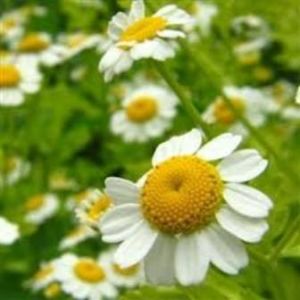
Chamomile

California Poppy
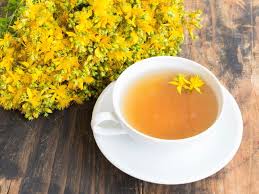
St. John's Wort Tea
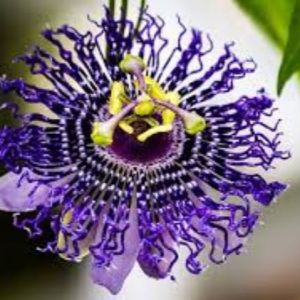
Passionflower
The Taste of Nervine Herbs
The bitter taste is cooling and drying and stimulates digestion and normalizes bowel elimination. These bitters that are nervines can really help calm and relax nervous digestion as a result of anxiety and stress and help improve stimulate digestion is it is sluggish as a result of depression.
Nervine herbs work on the nervous system with various results. Some are calming, sedative, pain killing, muscle relaxing and more. Each nervine herbs works differently on the nervous system.
Herbs with a bitter taste will also timulate the body’s systems, especially the digestive system. As your mouth tastes the bitterness, it signals the nervous system to release digestive juices from the saliva to your stomach acids and to stimulate bile. (a bitter greenish-brown alkaline fluid that aids digestion and is secreted by the liver and stored in the gallbladder)
In Summary
In summary, nervine herbs can be extremely helpful in times of stress and anxiety by nourishing and building the nervous system back up to a healthy state. If you are considering getting some chemical help, try some herbs first. Nervine herbs, in conjunction with natural relaxation therapies and learning to work with your thought processes and emotions, can be very powerful medicine indeed!
I have written a self-help course for you to help. Check it out below!

"Leverage the Power of Natural Healing Tools" Learn herbal remedies, diet and therapies to help heal your anxiety!
____________________________________________________________
Disclaimer: The information, including but not limited to, text, graphics, images and other material contained on this website are for informational purposes only. It is not intended to be a substitute for professional medical advice, diagnosis or treatment. Always seek the advice of your physician or other qualified health care provider with any questions you may have regarding a medical condition or treatment and before undertaking a new health care regimen.
All content in this article is for informational purposes only. The owner of these written materials makes no claims as to the accuracy or completeness of any of the information, including any links. The owner will not be liable for any errors or omissions in this information. The owner will not be liable for any losses, injuries, or damages from the use of this information.


